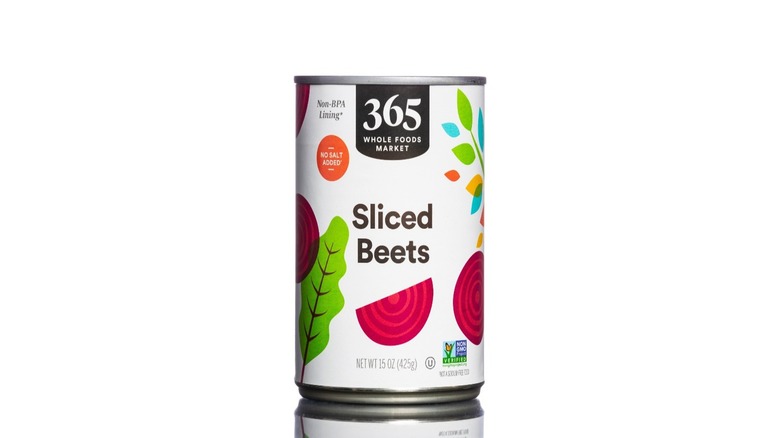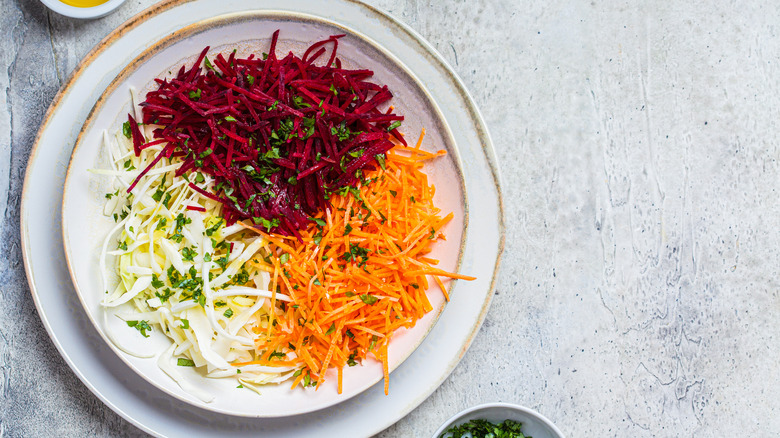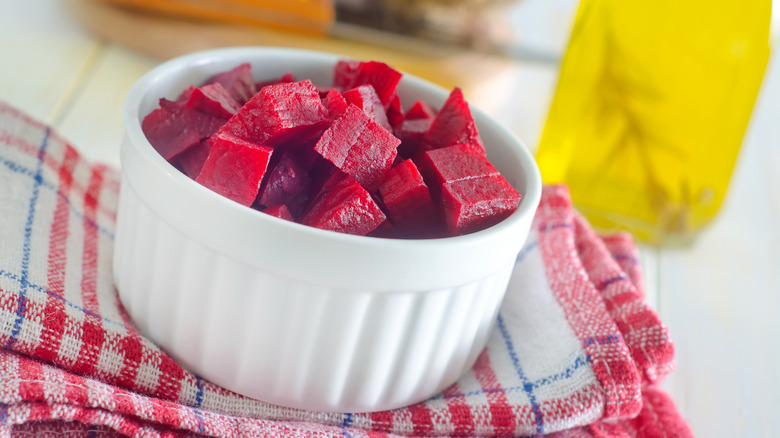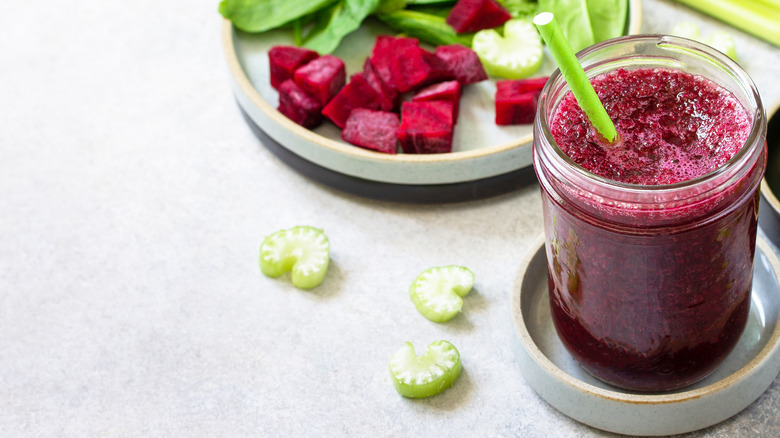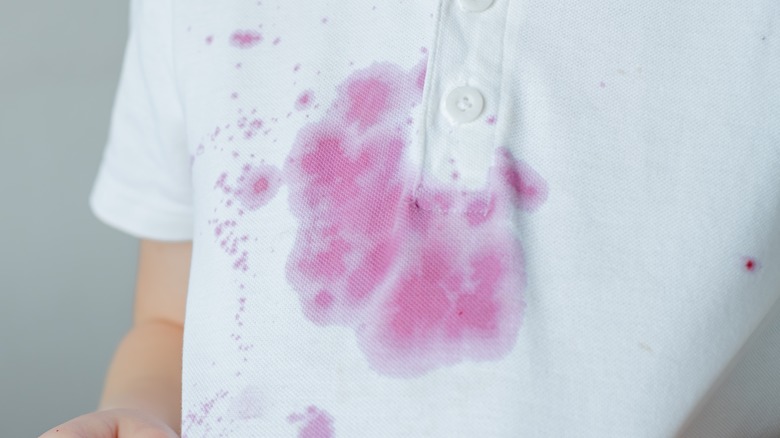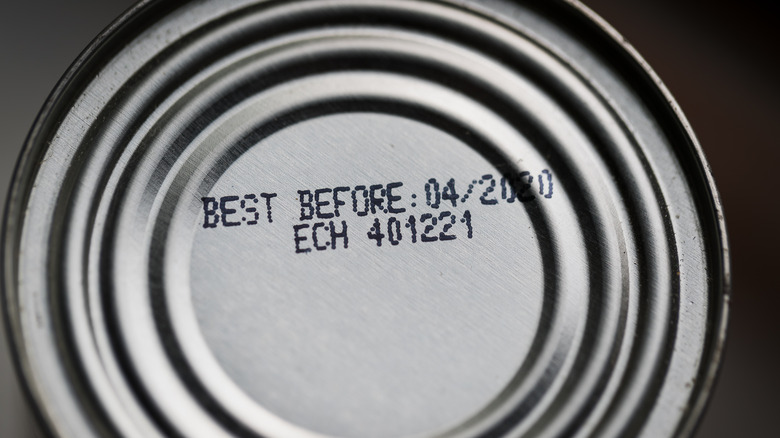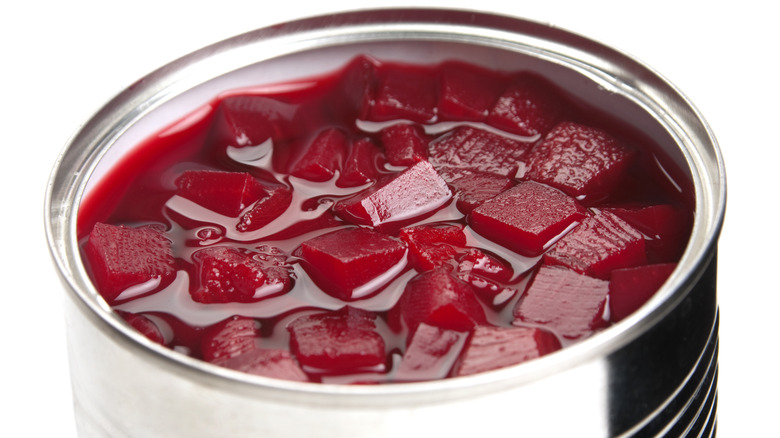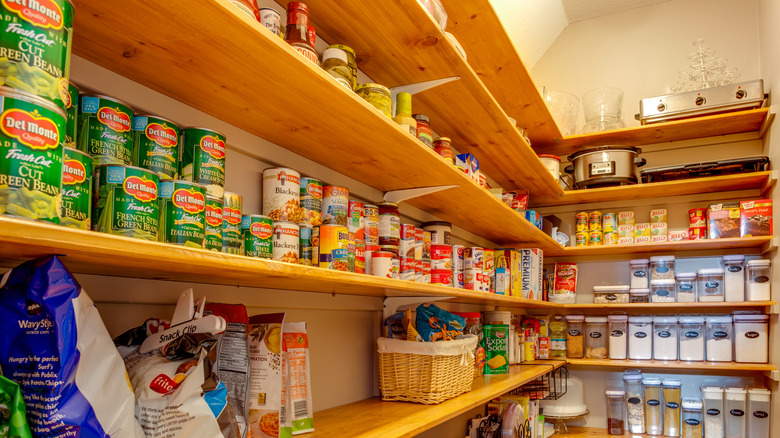The Biggest Mistakes You're Making With Canned Beets
Unlike some other vegetables — let's face it, corn — canned beets compare pretty favorably to the fresh version. However, they aren't one and the same, and you need to treat beets a bit differently if they didn't come to you right out of the ground.
To be clear, fresh beets do taste better than canned beets, but they're much less convenient: The tough root vegetable requires a long cooking time. Canned beets also have a longer shelf life, at least two years, according to Good Housekeeping. Even better, canned beets still have all of the health benefits of fresh beets. Nitrates, betalains, and other compounds in beets have been shown to positively affect cardiovascular health, cognition, and inflammation (via Consumer Reports).
If you are in fact a beet fan, and we're assuming you are since you're reading this, but you can't really get down with canned beets — it could be that you're making some mistakes. What mistakes are you making? Well, it's hard to say, but it could be some big ones. So if you're open to giving canned beets another shot, consider the following missteps you could be making.
Using them out of the can in fresh preparations
When beets and other vegetables are canned, they are essentially cooked twice: once in brine and once after being canned. This canning process helps to preserve vegetables, but it also completely strips them of any freshness. If you're using beets right out of the can in fresh preparations, it just won't compare to using fresh vegetables. With a little bit of sprucing up, however, you can still use canned beets and fresh preparations.
One way to liven up canned beets is to give them a splash of citrus juice. According to research from the journal Chemical Senses, citric acid on the tongue can evoke the olfactory sensation of fresh citrus flavor. Basically, you're borrowing some freshness from a lemon and transferring it to your canned beets.
Blanching is another technique you can use to mask the lack of freshness in canned beets (via Our Everyday Life). Simply submerged your beets in boiling water for two minutes and transfer them to an ice bath to stop the cooking process. This technique is best for salads, dips, and other cold preparations that include several other non-canned ingredients.
Forgetting to add fat
Recent research from the journal Processes has shown that part of the industrial canning process — cooking vegetables in water — can significantly decrease protein and natural sugar content while increasing moisture content. The result? Less flavorful vegetables. But you probably didn't need a team of scientists to tell you that canned vegetables don't taste as good as fresh ones. In fact, fresh-picked vegetables at your local farmer's market will typically taste better than the identical vegetable at your local supermarket. Simply put, fresher tastes better.
A quick fix for that loss of flavor is adding a bit of fat. Research has also shown that we primates simply associate fat with flavor. In a study published by The Journal of Neuroscience, an international team of scientists found our brains are stimulated by eating fat and the neurological response diminished as we feel satiated. Therefore, if you're looking to amp up the flavor of your canned beet dish, go ahead and add some extra olive oil, butter, cheese, or delicious bacon fat. Calling for full-fat yogurt, our roasted beets and strawberries recipe could easily be done with the canned variety.
Skipping the herbs and spices
The judicious addition of herbs and spices makes any dish pop, and spices are especially essential when trying to make canned foods more flavorful. The key is picking the right herbs. Whether beets in a recipe are fresh or canned, their earthy sweetness goes particularly well with a number of different herbs. In our spiralized beet salad recipe, we pair beets with mustard, mint, and parsley. In our beets with cranberries recipe, we pair the root vegetables with green cardamom.
Using fresh herbs will go a long way in compensating for canned beets' lack of freshness. If you are going to use fresh herbs with your beets, make sure you're chopping them in a way that preserves their flavor. For leafy herbs like parsley and mint, celebrity chef Gordon Ramsay recommends lightly rolling the leaves into a cigar shape and slicing across the 'cigar' to create thin strips of herbs. If you wish, these strips can then be minced.
It's best to only use dried herbs when cooking beets or as part of a dressing that goes over them. Strong flavored, cost-effective, and fuss-free — dried herbs should be added early on in the cooking process to impart the most flavor.
Overlooking any added salt
Canned beets with low sodium are available, but some canned beets do have added salt. It is often added as a way to help preserve the beets and compensate for the loss of flavor caused by the canning process (via FASEB). Added salt can come in handy if you are pickling canned beets, depending on the recipe. But most of us, especially those with cardiovascular conditions, should be mindful of our sodium intake. According to research, a high sodium intake can lead to higher blood pressure — increasing the risks of heart attack and stroke. Therefore, it is critical to check the label of your canned beets. If there is added salt or sugar, you need to take these additives into consideration.
Draining and rinsing canned vegetables in water can lower the level of their sodium content, notes FASEB. However, rising can also cause a loss of water-soluble vitamins. Therefore, if you are going to rinse canned beets, be sure to use them in a well-rounded, nutritious recipe.
Not playing into the benefits of canning
Canned beets lack the texture and flavor of fresh beets, and this isn't a bad thing. It's just different. Rather than being (unfavorably) compared to fresh beets, canned beets should be appreciated for their tender texture. These softer beets work particularly well in recipes that feature the root vegetables broken down by long cooking times, such as in stews or soups.
One of the best uses of canned beets is in our short rib borscht recipe. This recipe calls for fresh beats to be par-cooked, peeled, and then coarsely shredded. Since canned beets are already par-cooked and peeled, you can skip right to coarsely grating and adding them toward the end of the recipe.
If you're an incorrigible thrill-seeker looking for something modern, you could also behold the borscht burrito. Shown to us by NYC-based Tres Carnes owner Sasha Shor, the borscht burrito includes Russian-style rice pilaf, smoked brisket, roasted tomato salsa, cabbage slaw, sour cream, and beet pico de gallo.
Only going with savory beet recipes
Perhaps because they're a root vegetable, beets often get associated with savory dishes. However, the sweetness of beets naturally lends itself to dessert preparations. The sweetness of canned beets comes with an added bonus in the form of betanin, the compound responsible for beets' deep red color. Some people have difficulty processing this compound, resulting in the production of red-colored urine.
The combination of sweetness and coloration is perfectly suited for our red velvet beet cake recipe. It's important to point out that standard red velvet cake is simply chocolate cake with red food dye that is typically artificial. If you are using beets in your red velvet cake, there's nothing artificial about the coloration. On top of that, beats add a bit of root-vegetable earthiness that makes for a more complex cake.
A much fancier option is The New York Times recipe for beet pie, or tarte au betterave. In another sweet application, a BBC Food recipe of beetroot pie is a take on the all-American classic pumpkin pie.
Making a mess
One of the things you may know about beets is that the juice from them stains easily. A bit of preparation can keep your kitchen from becoming messier than a wedding in Game of Thrones.
Wearing disposable gloves and a plastic cutting board can go a long way to preventing beet juice stains. If your white plastic cutting board does get a bit of beet juice on it, you can easily remove it by scrubbing the stain with bleach. Wooden cutting boards should never be scrubbed with bleach, by the way.
If you don't have disposable gloves and your hands become stained red, scrubbing them with a combination of lemon juice and salt can help to remove the stains. Just be sure you don't have any open cuts before applying acid and salt to your hands. A normal wash with soap and water should remove any beet juice remnants.
If you happen to get a bit of beet juice on your clothes, Today recommends pretreating the stain with lemon juice or vinegar, allowing it to sit for five minutes, rinsing with water, and flushing the underside of the stain with diluted laundry detergent. After that pretreatment regimen, you can wash your clothes as usual.
Using them past their expiration date
You may have seen "Best by" or "Sell by" dates on packaged food and thought this is information you can trust. But the surprising truth about canned food expiration dates is that they are not mandated by the government, except when it comes to infant formula. According to experts, canned vegetables can last two years or more and canned beets can last up to five years on the shelf (via Good Housekeeping).
That being said, there are situations when something will go wrong and your beets spoil before they're supposed to, notes Dummies. If the beats have an odd appearance, it should be your first clue that something's gone wrong. Any discoloration, deterioration, or cloudiness is an indication that your beats have gone bad. Another big clue will be the presence of an unpleasant smell. Any physical damage to the can itself — such as corrosion or bulging — should also be seen as a red flag. At the end of the day, if something looks off, you probably shouldn't roll the dice on questionable canned beets.
Not putting an opened can back in the fridge
When you open a can of food and don't use the entire thing do you: A) scrape the remaining contents into a plastic container with a lid, or B) just stick the can back in the fridge? If you said 'A', you might be under the impression that putting a partly-used, open can of beets back in the fridge will lead to it quickly spoiling. Maybe you heard something about acid in the juice reacting with the can. But there's nothing wrong or unsafe about putting an opened can back in the fridge, especially if you cover it with plastic wrap or aluminum foil (via USDA).
Once you open a can of beets, they should essentially be treated as fresh beets. If stored in the fridge, your remaining beets should be good for around three days, but they may acquire a bit of a metallic taste the longer they sit in an opened can, says SBS. If you want to keep them for longer than that, you should probably seal them tightly and stick them in the freezer.
Not rotating the cans in your pantry
After a long trip to the grocery store, it's easy to just toss canned beets into the front of your pantry. But properly rotating your canned goods will make it easier to always use the freshest can and help to prevent anything from going bad.
The simplest way to rotate your canned goods is to follow the tried-and-true first-in-first-out approach. Start by deciding how you want to rotate, such as from back to front, or left to right. To make it easier to remember, write out your rotation on a piece of tape and stick it up in your cupboard or pantry. As you rotate your food, be sure to inspect each can for any damage or signs that your food has gone bad. You can also check your "Best by" dates and do a bit of inventory to make sure you are stocked up on your essentials.
If you are storing canned goods in your pantry and want to keep them organized, but don't want to spend money on a fancy organizer, there is a household item you could use to store canned food — a magazine holder. If you're storing a lot of canned goods, you can use multiple magazine holders and store different types of food in each one.
Drain pouring the juice
Canned beets come immersed in their watered-down juice that sometimes has added salt or sugar. You may want to dump it down your sink drain, but you shouldn't get rid of the liquid from canned beets because it's edible and can be used in several different ways.
Before repurposing your beet liquid, check the label on the can to see if any sugar or salt has been added. Better yet, give it a taste. If your liquid isn't overly salty, it can be used to add sweet earthiness to just about any recipe that calls for water. Low-sodium beet juice is best reused in smoothies, sauces, and spreads. If your beet liquid is salty, you can use it as a supplemental ingredient in savory recipes for soups and stews.
When repurposing beet liquid, it's important to note its bright red color. In some preparations, this can be a drawback, but it can also be used as a natural dye. A pickled egg recipe from Betty Crocker explicitly calls for dying with the canned beets liquid, with the beets themselves being reserved for another use. Another recipe for red velvet cake from Taste Atlas also makes exclusive use of the juice.
